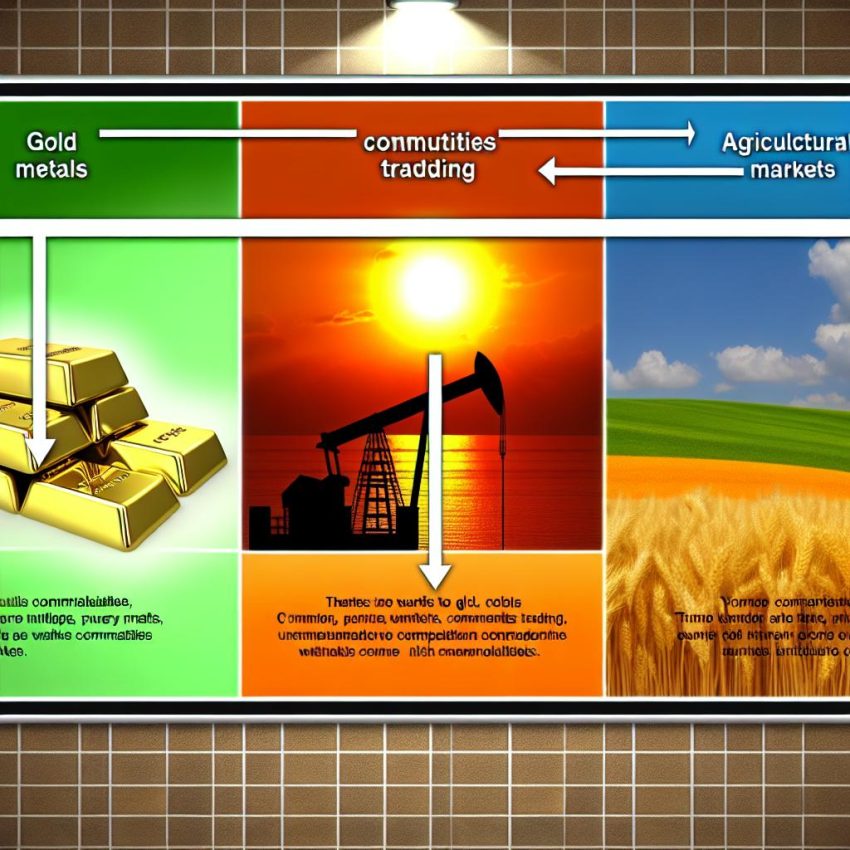Introduction to Commodities Trading
In the world of finance, commodities trading represents a significant component, encompassing essential goods such as gold, oil, and agricultural products. This type of trading entails the buying, selling, or exchanging of these raw materials. Investors and traders participate in commodities markets to diversify portfolios, hedge against inflation, and speculate on price movements.
One reason for the popularity of commodities trading is its role as a hedge against inflation. As prices rise, the value of commodities often increases, allowing investors to preserve purchasing power. Furthermore, since commodities are physical goods, their prices are influenced by factors beyond traditional markets, providing further diversification.
Gold: A Safe Haven Asset
Gold has a longstanding history as a valuable asset, often considered a safe haven during economic turbulence. Its price tends to be inversely related to equities, making it a common choice for hedging risks. Gold trading occurs in global financial markets, with major exchanges including the New York Mercantile Exchange (NYMEX) and the London Bullion Market.
Key factors influencing gold prices include geopolitical tensions, currency values, interest rates, and central bank policies. Gold is utilized in various industries beyond investment. Jewelry is a significant market, with consumers worldwide buying gold ornaments. Electronics also rely on gold due to its excellent conductivity and resistance to corrosion. Additionally, gold’s applications in dentistry demonstrate its diverse demand.
Investing in Gold
Investors can gain exposure to gold through various instruments such as physical gold, exchange-traded funds (ETFs), and futures contracts. Each investment method carries distinct risks and benefits. Physical gold offers the advantage of tangible ownership but comes with storage and insurance costs. ETFs provide easier trading access and liquidity but lack physical ownership. Futures contracts allow for speculation on gold prices without requiring physical delivery but entail higher risk due to market volatility.
For detailed guidance on gold investment, consult financial resources and experts with proven experience in the sector. Understanding historical trends, geopolitical factors, and currency influences is crucial for effective decision-making in gold trading.
Oil: The Lifeblood of the Global Economy
Oil remains a critical component of the global economy, primarily due to its role as a key energy source. The oil market is influenced by numerous factors, including geopolitical events, supply-demand dynamics, and production decisions by major organizations like the Organization of the Petroleum Exporting Countries (OPEC).
Market Dynamics
Oil trading often involves futures contracts, enabling market participants to lock in prices for future delivery. These contracts are traded on exchanges such as the Intercontinental Exchange (ICE) and the Commodity Exchange (COMEX). Traders must monitor a range of variables, such as technological advancements in extraction, environmental policies, and shifts in consumer demand, all of which can impact prices.
Production technologies, such as hydraulic fracturing and offshore drilling, have changed the supply landscape, affecting prices and market strategies. Environmental regulations, aiming to reduce carbon footprints, also influence oil demand, impacting trading strategies. Moreover, geopolitical tensions can lead to sudden price fluctuations, requiring traders to stay informed and flexible.
Agricultural Markets: Essential Goods and Volatility
Agricultural commodities include a variety of essential goods such as wheat, corn, soybeans, and coffee. These markets are characterized by significant volatility, driven by factors like weather conditions, global supply chains, and policy changes.
Weather impacts crop yields, causing supply variations that affect prices. Changes in global trade policies can either open new markets or restrict existing ones, directly influencing trade flows and pricing. Additionally, diseases affecting crops or livestock can lead to significant market shifts, further adding to volatility.
Trading Agricultural Commodities
Futures contracts are commonly utilized in agricultural trading, offering both risk management and speculative opportunities. Large exchanges like the Chicago Board of Trade (CBOT) and the Euronext provide platforms for trading these products.
Understanding seasonal patterns and external factors such as trade agreements is crucial for participants in these markets. Traders often use technical analysis and historical data to predict price movements, but they must also be aware of unexpected events like natural disasters that can unpredictably affect supply and demand.
Conclusion
Commodities trading is a complex but integral component of the global financial system, offering various opportunities for investment and diversification. Whether trading gold, oil, or agricultural goods, market participants must stay informed about industry trends and emerging factors that can impact prices.
For those interested in gaining deeper insight into commodities trading, analyzing resources from industry experts and financial institutions is essential. Continuous learning and adaptation to new information are key to successful trading in this dynamic market.
For further reading on commodities markets and strategies, explore resources provided by reputable financial news websites and educational platforms like this one. Comprehensive understanding and strategic planning are crucial for navigating the complexities of commodities trading, making informed decisions, and optimizing investment portfolios.
This article was last updated on: May 25, 2025


